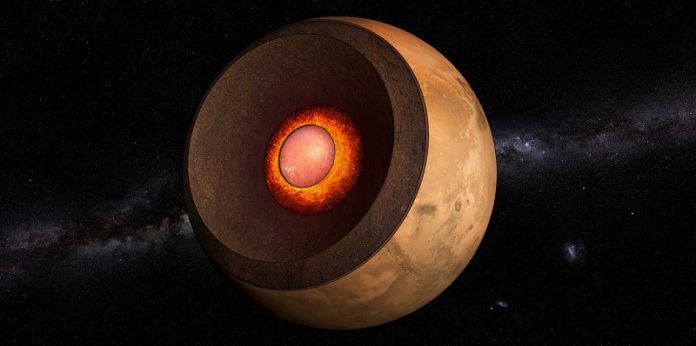
Ever thought about what lies inside Mars?
If you imagine it like a big chocolate truffle, you might be surprised at the layers inside!
NASA’s InSight lander spent four years listening to Mars’s rumbles, called marsquakes. Scientists have been studying these sounds to figure out what’s happening below the surface.
And guess what? They’ve found some pretty amazing stuff!
Mars’s Mysterious Middle
Scientists at ETH Zurich, led by Amir Khan, have been super busy looking at the data sent from InSight.
They found out that between Mars’s core (its center) and its mantle (a thick layer above the core) lies a 150-kilometer thick layer of melted minerals, like a gooey middle in our truffle! What’s extra cool is that Earth doesn’t have a layer like this.
What This Means for Mars’s Core
Earlier, scientists thought Mars’s core was a bit odd. It seemed to have too many light elements, making it different from Earth’s core. Earth’s core is mostly iron, with just a tiny bit (10%) of light elements. But Mars? Initial estimates said its core might have up to 20% light elements, which was puzzling!
However, with the new findings, scientists have realized Mars’s core is actually smaller and denser than they thought. If it’s smaller but weighs the same, it means it has fewer light elements than they guessed.
So, now they think Mars’s core has between 9 and 14% light elements. This makes a lot more sense in the big picture of how planets are formed.
And why does Mars’s core have these light elements? Scientists believe this means Mars’s core formed super early in our solar system’s history. Maybe when the sun still had a gas cloud around it from which these elements could join Mars’s core.
Listening to Mars’s Heartbeat
The initial marsquake data was a bit limited because the shakes happened near the InSight lander.
But in 2021, two big marsquakes came from the opposite side of Mars, and one was even caused by a meteorite crash! These rumbles sent seismic waves right through Mars’s core, giving scientists a clearer “X-ray” of the inside of the planet.
To understand the core’s makeup, scientists compared the marsquake data to what they know about different iron mixtures.
But there was a twist! The data didn’t quite fit with the expected iron-light element mix. This puzzle led them to realize that what they thought was the outer part of Mars’s core was actually the deep part of its mantle.
How did they figure this out? They noticed that the seismic waves in the outermost 150 kilometers of the core matched what you’d expect from melted minerals (like the mantle). Computer simulations and relooking at older marsquake data supported this cool discovery.
The Supercomputer’s Role
The ETH Zurich team didn’t just rely on the marsquake data. They also used powerful supercomputers to simulate Mars’s interior conditions.
At the Swiss National Supercomputing Center, they ran calculations on how different iron mixtures would behave. This combination of real-world data and computer simulations helped them understand Mars’s inside better.
It’s a bit sad, though, that the InSight lander couldn’t send more data. Dust on its solar panels reduced its power. But still, as Khan says, InSight was a great success. It sent so much information that scientists will be busy with it for years!
Key Takeaways
Mars keeps surprising us!
From a mysterious gooey layer to rethinking its core’s makeup, our understanding of the Red Planet just took a giant leap.
And with every discovery, we’re getting a step closer to unraveling the fascinating story of our solar neighbor.
Who knows what we’ll find out next!
Follow us on Twitter for more articles about this topic.
Source: ETH Zurich.



